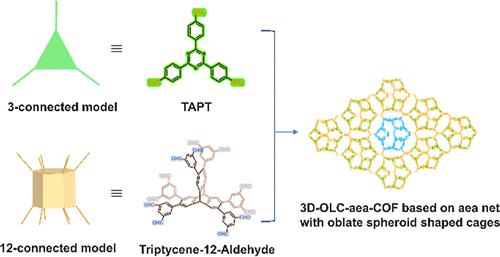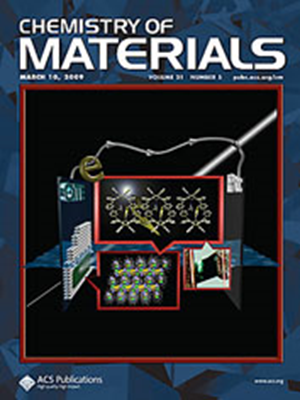Constructing Three-Dimensional Covalent Organic Framework with aea Topology and Flattened Spherical Cages
IF 7.2
2区 材料科学
Q2 CHEMISTRY, PHYSICAL
引用次数: 0
Abstract
Constructing three-dimensional (3D) covalent organic frameworks (COFs) with novel topologies is one of the most effective strategies to enhance the diversity and complexity of crystalline organic porous materials. Herein, we have designed and synthesized a 3D COF (3D-OLC-aea-COF, OLC = Ordos Laboratory China) with an unprecedented aea topology, condensed from the 12-connected building units (triptycene-12-aldehyde) and the planar 3-connected building units. Structural simulations and high-resolution transmission electron microscopy successfully determined the crystal structure. Interestingly, the unique connection between two precursors creates novel cages with large cavities and small windows within the framework, which will likely bring valuable implications for guest molecular storage and nanoreactors. Notably, huge intrinsic free volume (IFV) of triptycene and the periodic arrangement of cages endowed 3D-OLC-aea-COF with excellent CO2 capture capability. This work not only enhances the topological diversity and structural complexity of 3D COFs based on high-connectivity building units (≥8) but also provides inspiration for designing targeted materials through structure–activity relationships.

构建具有新拓扑结构的三维(3D)共价有机框架(COFs)是提高晶体有机多孔材料多样性和复杂性的最有效策略之一。在这里,我们设计并合成了一种具有前所未有的aea拓扑结构的三维共价有机框架(3D-OLC-aea-COF,OLC = 中国鄂尔多斯实验室),它是由12个连接的构筑单元(三庚烯-12-醛)和3个连接的平面构筑单元凝结而成的。结构模拟和高分辨率透射电子显微镜成功确定了其晶体结构。有趣的是,两种前体之间的独特连接在框架内形成了具有大空腔和小窗口的新型笼状结构,这可能会为客体分子存储和纳米反应器带来有价值的影响。值得注意的是,三庚烯巨大的本征自由体积(IFV)和笼的周期性排列赋予了 3D-OLC-aea-COF 极佳的二氧化碳捕获能力。这项工作不仅增强了基于高连接性构建单元(≥8)的三维 COF 的拓扑多样性和结构复杂性,还为通过结构-活性关系设计目标材料提供了灵感。
本文章由计算机程序翻译,如有差异,请以英文原文为准。
求助全文
约1分钟内获得全文
求助全文
来源期刊

Chemistry of Materials
工程技术-材料科学:综合
CiteScore
14.10
自引率
5.80%
发文量
929
审稿时长
1.5 months
期刊介绍:
The journal Chemistry of Materials focuses on publishing original research at the intersection of materials science and chemistry. The studies published in the journal involve chemistry as a prominent component and explore topics such as the design, synthesis, characterization, processing, understanding, and application of functional or potentially functional materials. The journal covers various areas of interest, including inorganic and organic solid-state chemistry, nanomaterials, biomaterials, thin films and polymers, and composite/hybrid materials. The journal particularly seeks papers that highlight the creation or development of innovative materials with novel optical, electrical, magnetic, catalytic, or mechanical properties. It is essential that manuscripts on these topics have a primary focus on the chemistry of materials and represent a significant advancement compared to prior research. Before external reviews are sought, submitted manuscripts undergo a review process by a minimum of two editors to ensure their appropriateness for the journal and the presence of sufficient evidence of a significant advance that will be of broad interest to the materials chemistry community.
 求助内容:
求助内容: 应助结果提醒方式:
应助结果提醒方式:


